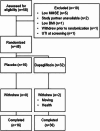Effects of the SGLT2 inhibitor dapagliflozin in early Alzheimer's disease: A randomized controlled trial
- PMID: 40566796
- PMCID: PMC12198475
- DOI: 10.1002/alz.70416
Effects of the SGLT2 inhibitor dapagliflozin in early Alzheimer's disease: A randomized controlled trial
Abstract
Introduction: Due to its metabolic effects, dapagliflozin, a sodium-glucose transporter 2 (SGLT2) inhibitor, holds potential as an Alzheimer's disease (AD) therapeutic.
Methods: We conducted a double-blind, randomized, placebo-controlled, parallel-group, 12-week single-site study to investigate the effect of dapagliflozin in participants with probable AD (Mini-Mental State Examination [MMSE] score 15-26). We planned to enroll 48 participants with 2:1 randomization to 10 mg dapagliflozin once daily (n = 32) versus matching placebo (n = 16). The primary objective was the effect of dapagliflozin on cerebral N-acetylaspartate (NAA). We also assessed safety, glycemic control, body composition, brain metabolism, and cognition.
Results: There was no change in the primary outcome. There were no significant adverse event differences. Hemoglobin A1c, fat mass, and fat-free lean mass decreased; brain glutathione increased; and Stroop Interference test (but not other cognitive test) performance improved.
Discussion: Treated participants manifested metabolic effects observed in clinical studies of other cohorts. In AD, dapagliflozin use may affect the brain.
Highlights: Dapagliflozin did not alter magnetic resonance spectroscopy N-acetylaspartate (primary outcome) in this exploratory Alzheimer's disease (AD) trial. Dapagliflozin-induced glucose disposal is sufficient to alter systemic metabolism. AD patients taking dapagliflozin exhibited metabolic effects seen in diabetics.
Keywords: Alzheimer's; MRS; SGLT2; dapagliflozin; glucose; metabolism.
© 2025 The Author(s). Alzheimer's & Dementia published by Wiley Periodicals LLC on behalf of Alzheimer's Association.
Conflict of interest statement
J.M.B. received honoraria and travel reimbursements from AstraZeneca. R.H.S., I.Y.C., P.L., and W.B. received travel reimbursement from AstraZeneca to attend meetings. R.E. and J.O. are employed by AstraZeneca and are AstraZeneca stockholders. J.K.M., E.D.V., H.W., S.L.H., J.D.M., R.J.C., and A.G. have no disclosures to report related to the work presented here. Author disclosures are available in the Supporting Information.
Figures



References
-
- Craft S. Insulin resistance and Alzheimer's disease pathogenesis: potential mechanisms and implications for treatment. Curr Alzheimer Res. 2007;4:147‐152. - PubMed
-
- Haan MN. Therapy Insight: type 2 diabetes mellitus and the risk of late‐onset Alzheimer's disease. Nat Clin Pract Neurol. 2006;2:159‐166. - PubMed
Publication types
MeSH terms
Substances
Grants and funding
LinkOut - more resources
Full Text Sources
Medical

